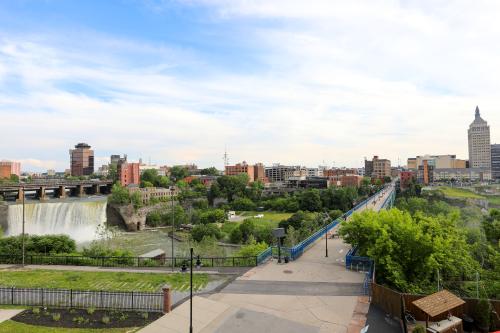This analysis is part of the American Rescue Plan: Strategies for Local Leaders series, a feature of the COVID-19 Metro Recovery Watch.
From rural downtowns to urban commercial corridors, local business districts are centers of civic life and commercial activity. But even before the COVID-19 pandemic, many of these districts already faced serious challenges, including decades of disinvestment, limited access to capital and broadband, brain drain, and competition from big box and online retail, to name just a few.
Today, these problems have only intensified, with shutdowns and capacity limitations decimating revenue streams for small businesses, particularly as many consumers switch to online shopping (nearly two-thirds of small businesses have no online presence). Many districts that once depended on office workers for foot traffic also face a challenging future, with McKinsey & Company estimating that more than 20% of workers will not return to traditional offices. Forty-four percent of small businesses closed during the pandemic, and full recovery still seems a distant goal in many downtowns and neighborhood commercial districts throughout the country.
The American Rescue Plan Act (ARP)—and particularly, its $350 billion in state and local funding—offers a lifeline for these struggling Main Streets.
ARP’s intention is to lay a foundation for a strong and equitable economic recovery. With broad allowable uses of its funds, many municipal leaders are likely to prioritize long-term infrastructure investments in areas such as water, sewer, and broadband. For struggling communities with long-standing needs for revitalization, these projects are essential to a healthy local economy.
But local leaders must also be mindful of the pandemic’s direct and devastating impact on small businesses, and buttress infrastructure projects with strategic investments in not only small businesses, but the places and organizations that are essential to their recovery.
Using ARP funds to support local business districts
While large federal programs such as the Paycheck Protection Program and Economic Injury Disaster Loans helped keep individual businesses afloat during the pandemic, many communities used local pots of funding for emergency grants or revolving loans to address the needs of entrepreneurs efficiently and equitably. In Royal Oak, Mich., for example, the city used proceeds from a land sale to provide $1.1 million in grants to 92 small businesses.
ARP funding opens the opportunity for all communities to develop similar programs to support impacted businesses, including those that were disadvantaged in accessing federal programs. In May, the Department of the Treasury released substantial guidance on ARP funds, with clearly identified uses for state, county, and local leaders to assist businesses with grants, loans, and technical assistance—all desperately needed to sustain them through the pandemic’s turbulence.
To fully support small business recovery, though, municipal leaders should look beyond supporting businesses individually and consider holistic strategies that support local business district recovery. Such place-based investments can help restore foot traffic through physical improvements, district-based marketing, and special events, as well as leverage economies of scale to support business owners en masse in finding needed sources of capital and technical services to stabilize or grow their business. District-scale interventions are also key to making the most from the surge of “covidpreneurs,” providing vital sources of support to these new business owners and quickly filling pandemic-induced vacancies.
Cities should take advantage of ARP’s flexibility to support district activities and, where appropriate, use district-based public-private organizations—typically 501(c)(3) or 501(c)(6) nonprofits that serve as ground-level resources for local businesses—to coordinate them. Such efforts could include:
Connecting entrepreneurs to capital and technical assistance. Throughout the pandemic, business district organizations triaged and responded to small business needs with creative programs. For example, in Gloucester Village, Va., the Main Street Preservation Trust created an e-commerce platform and leveraged private funding to sell over $150,000 in discounted gift cards for downtown businesses, creating immediate cash flow and a stable customer base. In North Little Rock, Ark., the Argenta Downtown Council worked with the city and local businesses to manage pandemic restrictions to create outdoor dining opportunities. Such programs are critical to helping small businesses keep their doors open and adapt to change.
Ensuring the physical environment is advantageous for local commerce. Looking forward, the challenge—and opportunity—for business district recovery is to leverage the sharp rise in entrepreneurship rates by investing in supportive infrastructure and placemaking activities. Place-management projects (such as district-wide marketing plans), place-activation efforts (such as markets and festivals), and streetscape improvements are key to the well-being of local businesses and the revitalization of these districts.
Supporting entrepreneurial ecosystem development. Finally, municipalities can and must work with business district organizations to reduce barriers for new startups, connect new and aspiring business owners to available incentives and support systems, and support existing business owners regain stable footing post-pandemic. Further—through development of business incubators, co-working spaces and pop-up shops—cities can help entrepreneurs become tenants or owners, filling storefront and upper-floor vacancies.
For municipal leaders and communities ready to act in support of entrepreneurial growth and district revitalization, ARP offers two pathways to support local business district recovery. First, cities have wide discretion in the use of ARP funds identified as revenue replacement via the Treasury Department formula, and can allocate revenue replacement dollars in support of business district recovery. Alternately, ARP specifically identifies business districts as an impacted industry, thus permitting funding of district recovery. However, confusion exists regarding how to measure COVID-19’s negative impacts in business districts, creating some concern that deploying ARP dollars through this channel could result in a “claw back” of federal funding. Better guidance from Treasury is needed on how specifically to measure negative impacts in business districts.
For many of America’s small business owners and business districts, the recovery is only just beginning. With deep revenue losses sustained during the roller coaster of closures and partial openings, seismic changes in Americans’ shopping patterns, and new work-from-home norms that are likely to continue to reduce foot traffic, America’s small businesses remain in peril. The American Rescue Plan’s investments in small business—and the districts in which they are located—can support the nation’s small business owners in adapting to and thriving in our post-pandemic world.









Commentary
The American Rescue Plan can be a lifeline for business districts
July 12, 2021